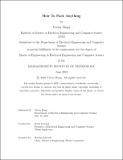| dc.contributor.advisor | Durand, Frédo | |
| dc.contributor.author | Rong, Victor | |
| dc.date.accessioned | 2023-07-31T19:32:33Z | |
| dc.date.available | 2023-07-31T19:32:33Z | |
| dc.date.issued | 2023-06 | |
| dc.date.submitted | 2023-06-06T16:34:46.131Z | |
| dc.identifier.uri | https://hdl.handle.net/1721.1/151340 | |
| dc.description.abstract | 3D printers can make anything, from household tools to rocket engines, so long as the models can be packed into a given enclosure. The denser the packing, the more efficient the print is. Unfortunately, modern packing research has struggled with complex shapes and even proprietary packing software is not capable of effectively processing the wide variety of models created for 3D printing. A recent work (Spectral Packing [1]) uses the frequency space of a voxel grid to achieve impressive performance. However, voxel grids present their own challenges as their resolution and complexity are intrinsically linked. Our proposed extension alleviates these issues by allowing sub-voxel positioning, faster disassembly of loose objects, and incorporating a combinatorial search algorithm of tunable complexity. With these elements, we achieve improved results of packing arbitrary 3D objects. | |
| dc.publisher | Massachusetts Institute of Technology | |
| dc.rights | In Copyright - Educational Use Permitted | |
| dc.rights | Copyright retained by author(s) | |
| dc.rights.uri | https://rightsstatements.org/page/InC-EDU/1.0/ | |
| dc.title | How To Pack Anything | |
| dc.type | Thesis | |
| dc.description.degree | M.Eng. | |
| dc.contributor.department | Massachusetts Institute of Technology. Department of Electrical Engineering and Computer Science | |
| mit.thesis.degree | Master | |
| thesis.degree.name | Master of Engineering in Electrical Engineering and Computer Science | |
